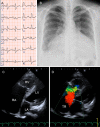Moyamoya Disease Complicating Ebstein's Anomaly
- PMID: 35569986
- PMCID: PMC9841108
- DOI: 10.2169/internalmedicine.9516-22
Moyamoya Disease Complicating Ebstein's Anomaly
Abstract
Ebstein's anomaly is an uncommon congenital disorder affecting the tricuspid valve. We herein report a 38-year-old woman who experienced consciousness and sensory disturbance during treatment for heart failure caused by Ebstein's anomaly. Urgent magnetic resonance imaging and cerebral angiography demonstrated acute cerebral infarction and internal carotid artery obstruction with the development of collateral arteries. We diagnosed her with multiple cerebral infarctions due to moyamoya disease. Ebstein's anomaly concomitant with moyamoya disease is extremely rare. However, we should consider the possibility of this rare but important concurrence when treating patients with heart failure due to Ebstein's anomaly to avoid excessive diuresis and vasodilation and irreversible brain injury.
Keywords: Ebstein's anomaly; cerebral infarction; heart failure; moyamoya disease.
Conflict of interest statement
Figures


References
-
- Stout KK, Daniels CJ, Aboulhosn JA, et al. . 2018 AHA/ACC guideline for the management of adults with congenital heart disease: executive summary: a report of the American College of Cardiology/American Heart Association Task Force on Clinical Practice Guidelines. Circulation 139: e637-e697, 2019. - PubMed
-
- Lupo PJ, Langlois PH. Epidemiology of Ebstein anomaly: prevalence and patterns in Texas, 1999-2005. Am J Med Genet A 155: 1007-1014, 2011. - PubMed
-
- Attenhofer Jost CH, Connolly HM, Dearani JA, Edwards WD, Danielson GK. Ebstein's anomaly. Circulation 115: 277-285, 2007. - PubMed
-
- Research Committee on the Pathology and Treatment of Spontaneous Occlusion of the Circle of Willis, Health Labour Sciences Research Grant for Research on Measures for Intractable Diseases. Guidelines for diagnosis and treatment of moyamoya disease (spontaneous occlusion of the circle of Willis). Neurol Med Chir (Tokyo) 52: 245-266, 2012. - PubMed
-
- Baba T, Houkin K, Kuroda S. Novel epidemiological features of moyamoya disease. J Neurol Neurosurg Psychiatry 79: 900-904, 2008. - PubMed

